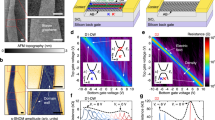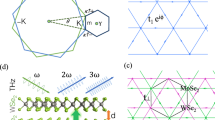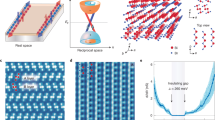Abstract
Symmetry and topology are central to understanding quantum Hall ferromagnets (QHFMs), two-dimensional electronic phases with spontaneously broken spin or pseudospin symmetry whose wavefunctions also have topological properties1,2. Domain walls between distinct broken-symmetry QHFM phases are predicted to host gapless one-dimensional modes—that is, quantum channels that emerge because of a topological change in the underlying electronic wavefunctions at such interfaces. Although various QHFMs have been identified in different materials3,4,5,6,7,8, interacting electronic modes at these domain walls have not been probed. Here we use a scanning tunnelling microscope to directly visualize the spontaneous formation of boundary modes at domain walls between QHFM phases with different valley polarization (that is, the occupation of equal-energy but quantum mechanically distinct valleys in the electronic structure) on the surface of bismuth. Spectroscopy shows that these modes occur within a topological energy gap, which closes and reopens as the valley polarization switches across the domain wall. By changing the valley flavour and the number of modes at the domain wall, we can realize different regimes in which the valley-polarized channels are either metallic or develop a spectroscopic gap. This behaviour is a consequence of Coulomb interactions constrained by the valley flavour, which determines whether electrons in the topological modes can backscatter, making these channels a unique class of interacting one-dimensional quantum wires. QHFM domain walls can be realized in different classes of two-dimensional materials, providing the opportunity to explore a rich phase space of interactions in these quantum wires.
This is a preview of subscription content, access via your institution
Access options
Access Nature and 54 other Nature Portfolio journals
Get Nature+, our best-value online-access subscription
$29.99 / 30 days
cancel any time
Subscribe to this journal
Receive 51 print issues and online access
$199.00 per year
only $3.90 per issue
Buy this article
- Purchase on Springer Link
- Instant access to full article PDF
Prices may be subject to local taxes which are calculated during checkout




Similar content being viewed by others
Data availability
The data that support the findings of this study are available from the corresponding author on reasonable request.
References
Girvin, S. M. in Topological Aspects of Low Dimensional Systems, Les Houches Session LXIX (eds Comtet, A. et al.) 53–175 (Springer, Berlin, 1999).
Ezawa, Z. F. & Tsitsishvili, G. Quantum Hall ferromagnets. Rep. Prog. Phys. 72, 086502 (2009).
Barrett, S. E., Dabbagh, G., Pfeiffer, L. N., West, K. W. & Tycko, R. Optically pumped NMR evidence for finite-size skyrmions in GaAs quantum wells near Landau level filling v = 1. Phys. Rev. Lett. 74, 5112–5115 (1995).
Schmeller, A., Eisenstein, J. P., Pfeiffer, L. N. & West, K. W. Evidence for skyrmions and single spin flips in the integer quantized Hall effect. Phys. Rev. Lett. 75, 4290–4293 (1995).
Shayegan, M. et al. Two-dimensional electrons occupying multiple valleys in AlAs. Phys. Status Solidi B 243, 3629–3642 (2006).
Kott, T. M., Hu, B., Brown, S. H. & Kane, B. E. Valley-degenerate two-dimensional electrons in the lowest Landau level. Phys. Rev. B 89, 041107 (2014).
Young, A. F. et al. Spin and valley quantum Hall ferromagnetism in graphene. Nat. Phys. 8, 550–556 (2012).
Zhu, Z., Collaudin, A., Fauqué, B., Kang, W. & Behnia, K. Field-induced polarization of Dirac valleys in bismuth. Nat. Phys. 8, 89–94 (2012).
Abanin, D. A., Parameswaran, S. A., Kivelson, S. A. & Sondhi, S. L. Nematic valley ordering in quantum Hall systems. Phys. Rev. B 82, 035428 (2010).
Li, X., Zhang, F. & MacDonald, A. H. SU(3) Quantum Hall Ferromagnetism in SnTe. Phys. Rev. Lett. 116, 026803 (2016).
Kane, C. L. & Fisher, M. P. A. Transport in a one-channel Luttinger liquid. Phys. Rev. Lett. 68, 1220–1223 (1992).
Bockrath, M. et al. Luttinger-liquid behaviour in carbon nanotubes. Nature 397, 598–601 (1999).
Ishii, H. et al. Direct observation of Tomonaga–Luttinger-liquid state in carbon nanotubes at low temperatures. Nature 426, 540–544 (2003).
Auslaender, O. M. et al. Spin-charge separation and localization in one dimension. Science 308, 88–92 (2005).
Chang, A. M., Pfeiffer, L. N. & West, K. W. Observation of chiral Luttinger behavior in electron tunneling into fractional quantum Hall edges. Phys. Rev. Lett. 77, 2538–2541 (1996).
Feldman, B. E. et al. Observation of a nematic quantum Hall liquid on the surface of bismuth. Science 354, 316–321 (2016).
Randeria, M. T. et al. Ferroelectric quantum Hall phase revealed by visualizing Landau level wavefunction interference. Nat. Phys. 14, 796–800 (2018).
Callan, C. G. & Harvey, J. A. Anomalies and fermion zero modes on strings and domain walls. Nucl. Phys. B 250, 427–436 (1985).
Agarwal, K., Randeria, M. T., Yazdani, A., Sondhi, S. L. & Parameswaran, S. A. Symmetry-protected Luttinger liquids at domain walls in quantum Hall nematics. Preprint at https://arxiv.org/abs/1807.10293 (2018).
Hofmann, P. The surfaces of bismuth: structural and electronic properties. Prog. Surf. Sci. 81, 191–245 (2006).
Misra, S. et al. Design and performance of an ultra-high vacuum scanning tunneling microscope operating at dilution refrigerator temperatures and high magnetic fields. Rev. Sci. Instrum. 84, 103903 (2013).
Hasan, M. Z. & Kane, C. L. Colloquium: topological insulators. Rev. Mod. Phys. 82, 3045–3067 (2010).
Ju, L. et al. Topological valley transport at bilayer graphene domain walls. Nature 520, 650–655 (2015).
Yin, L.-J., Jiang, H., Qiao, J.-B. & He, L. Direct imaging of topological edge states at a bilayer graphene domain wall. Nat. Commun. 7, 11760 (2016).
Huang, S. et al. Emergence of topologically protected helical states in minimally twisted bilayer graphene. Phys. Rev. Lett. 121, 037702 (2018).
Kumar, A., Parameswaran, S. A. & Sondhi, S. L. Microscopic theory of a quantum Hall Ising nematic: domain walls and disorder. Phys. Rev. B 88, 045133 (2013).
Maher, P. et al. Evidence for a spin phase transition at charge neutrality in bilayer graphene. Nat. Phys. 9, 154–158 (2013).
Xu, X., Yao, W., Xiao, D. & Heinz, T. F. Spin and pseudospins in layered transition metal dichalcogenides. Nat. Phys. 10, 343–350 (2014).
Dziawa, P. et al. Topological crystalline insulator states in Pb1−xSnxSe. Nat. Mater. 11, 1023–1027 (2012).
Hsieh, T. H. et al. Topological crystalline insulators in the SnTe material class. Nat. Commun. 3, 982 (2012); erratum 4, 1901 (2013).
Chamon, C., Oshikawa, M. & Affleck, I. Junctions of three quantum wires and the dissipative Hofstadter model. Phys. Rev. Lett. 91, 206403 (2003).
Acknowledgements
The experiments in this project were primarily supported by the Gordon and Betty Moore Foundation as part of the EPiQS initiative (GBMF4530) (B.E.F., H.D., A.Y.) and DOE-BES grant DE-FG02-07ER46419 (M.T.R., A.Y.). Other financial support for the experimental effort came from NSF-DMR-1608848 (A.Y.), NSF-MRSEC programs through the Princeton Center for Complex Materials DMR-142054 (A.Y., R.J.C.) and a Dicke fellowship (B.E.F.). A.Y. acknowledges the hospitality of The Aspen Center for Physics supported under NSF grant PHY-1607611. K.A. acknowledges support from DOE-BES grant no. DE-SC0002140 and from a private bequest to Princeton University by the UK foundation. S.A.P. acknowledges support from NSF DMR-1455366 during the early stages of this project. We acknowledge discussions with S. Kivelson and E. Fradkin.
Reviewer information
Nature thanks Brian LeRoy and the other anonymous reviewer(s) for their contribution to the peer review of this work.
Author information
Authors and Affiliations
Contributions
M.T.R., B.E.F., H.D. and A.Y. designed and conducted the STM measurements and their analysis. K.A., S.L.S. and S.A.P performed the theoretical calculations. H.J. and R.J.C. synthesized the samples. All authors contributed to the writing of the manuscript.
Corresponding author
Ethics declarations
Competing interests
The authors declare no competing interests.
Additional information
Publisher’s note: Springer Nature remains neutral with regard to jurisdictional claims in published maps and institutional affiliations.
Extended data figures and tables
Extended Data Fig. 1 Role of electron–electron interactions in domain-wall formation.
a, Spectrum away from the domain wall at B = 13.1 T and T = 250 mK, where the effective filling factor \(\widetilde{\nu }=0\), so the fourfold-degenerate Landau level is not split by exchange. b, Conductance map at the fourfold-degenerate Landau level peak energy E = 700 μeV in the same area as in Fig. 2. The presence of cyclotron orbits of both orientations throughout the image indicates the absence of a domain wall under these conditions. c, Spectroscopic line-cut along the dashed line in b also show a fourfold-degenerate Landau level that does not change across the original location of the domain wall, in stark contrast to the line-cut in Fig. 3a. d, Spectrum away from the domain wall at B = 14 T corresponding to the \(\widetilde{\nu }=2\) domain wall but at a higher temperature of T = 2 K. Again, we do not resolve any exchange splitting, and the Landau level is fourfold degenerate. e, Topography of the same area (identical to Fig. 2d) overlaid with a dI/dV map at E = −100 μeV. We observe cyclotron orbits of both orientations at this increased temperature, and no domain wall is visible. f, Line-cut along the dashed line in e. The absence of splitting in the fourfold-degenerate Landau level confirms that the domain wall is not present at 2 K.
Extended Data Fig. 2 Schematic of strain field and comparison to experimental line-cut.
a, Schematic of possible strain field (top) and the resulting energies of the different valley states (bottom). A large component of the strain in the direction of valleys C and \(\bar{{\rm{C}}}\) lowers the energy of these two valleys compared with the other four. In the presence of exchange interactions, the switch in strain field from a slight favouring of valleys A and \(\bar{{\rm{A}}}\) to valleys B and \(\bar{{\rm{B}}}\) gives rise to the nematic domain wall. b, Experimental line-cut across the \(\widetilde{\nu }=2\) domain wall showing that the energy of the twofold-degenerate valley state (corresponding to C and \(\bar{{\rm{C}}}\) at E ≈ −1.25 meV) is split off from the other valley states by strain, and does not change substantially across the domain wall associated with the crossing between pairs of valleys (A, \(\bar{{\rm{A}}}\)) and (B, \(\bar{{\rm{B}}}\)) at the Fermi level.
Extended Data Fig. 3 Energy-dependence of the domain-wall behaviour at \(\widetilde{{\boldsymbol{\nu }}}{\bf{=\; 2}}\).
a–i, Differential conductance maps measured in the same location and under identical conditions to those in Fig. 2c. Each panel shows dI/dV at a different energy, ranging from the lower-energy exchange-split Landau level at E = −400 μeV (a) to the higher-energy Landau level peak at E = 400 μeV (i). The data demonstrate the different preferred wavefunction orientations for each respective domain as well as the different orientations of occupied and unoccupied states within a given domain.
Extended Data Fig. 4 Energy-dependence of the domain-wall behaviour at \(\widetilde{{\boldsymbol{\nu }}}{\bf{=\; 1}}\).
a–d, Differential conductance maps measured in the same location and under identical conditions to those in Fig. 2e. Each panel shows dI/dV at a different energy, ranging from the singly degenerate LL at E = −120 μeV (a) to the triply degenerate LL peak at E = 330 μeV (d).
Extended Data Fig. 5 Additional spectroscopic line-cuts across the domain wall.
a–f, Spectroscopic line-cuts across the \(\widetilde{\nu }=2\) domain wall. The six different line-cut trajectories are indicated by the dashed lines in m. Although minor variations in the spectra are seen, probably due to the effects of local disorder, the key features of exchange gap closing and Landau level crossing at the domain wall are consistent. g–l, Spectroscopic line-cuts across the \(\widetilde{\nu }=1\) domain wall. Again, the same features of the change in topological invariant are present in each line-cut. m, n, dI/dV maps reproduced from Fig. 2c and Fig. 2e, respectively, overlaid with dashed lines showing the locations of the spectroscopic line-cuts in a–l.
Extended Data Fig. 6 Variation in individual spectra at the domain wall.
a, Individual spectra (blue, green, brown, purple, black, red) measured for \(\widetilde{\nu }=2\) (a) and \(\widetilde{\nu }=1\) (b), at domain-wall positions corresponding to line 1 to line 6 (Extended Data Fig. 5). All spectra in a show a charge gap Δcharge that is smaller than the exchange gap far from the domain wall (grey dashed spectrum). No Landau level splitting is visible at the \(\widetilde{\nu }=1\) domain wall (b), in contrast to the behaviour in a and far from the domain wall (grey dashed spectrum).
Extended Data Fig. 7 Line-cut along \(\widetilde{{\boldsymbol{\nu }}}{\bf{=\; 2}}\) domain wall.
a, Line-cut parallel to the \(\widetilde{\nu }=2\) domain wall, along the white line in b, showing spatial variation in the spectra. b, Conductance map reproduced from Fig. 2c, with the location of the spectroscopic line-cut in a marked by the white line.
Supplementary information
Supplementary Information
This file contains the theoretical modelling of nematic domain-wall behaviour, including Hartree–Fock calculations and modelling of boundary modes using symmetry based Luttinger liquid analysis.
Rights and permissions
About this article
Cite this article
Randeria, M.T., Agarwal, K., Feldman, B.E. et al. Interacting multi-channel topological boundary modes in a quantum Hall valley system. Nature 566, 363–367 (2019). https://doi.org/10.1038/s41586-019-0913-0
Received:
Accepted:
Published:
Issue Date:
DOI: https://doi.org/10.1038/s41586-019-0913-0
This article is cited by
-
A robust and tunable Luttinger liquid in correlated edge of transition-metal second-order topological insulator Ta2Pd3Te5
Nature Communications (2023)
-
Chern mosaic and Berry-curvature magnetism in magic-angle graphene
Nature Physics (2022)
-
Evidence of two-dimensional flat band at the surface of antiferromagnetic kagome metal FeSn
Nature Communications (2021)
-
Intriguing one-dimensional electronic behavior in emerging two-dimensional materials
Nano Research (2021)
-
Strongly correlated Chern insulators in magic-angle twisted bilayer graphene
Nature (2020)
Comments
By submitting a comment you agree to abide by our Terms and Community Guidelines. If you find something abusive or that does not comply with our terms or guidelines please flag it as inappropriate.



